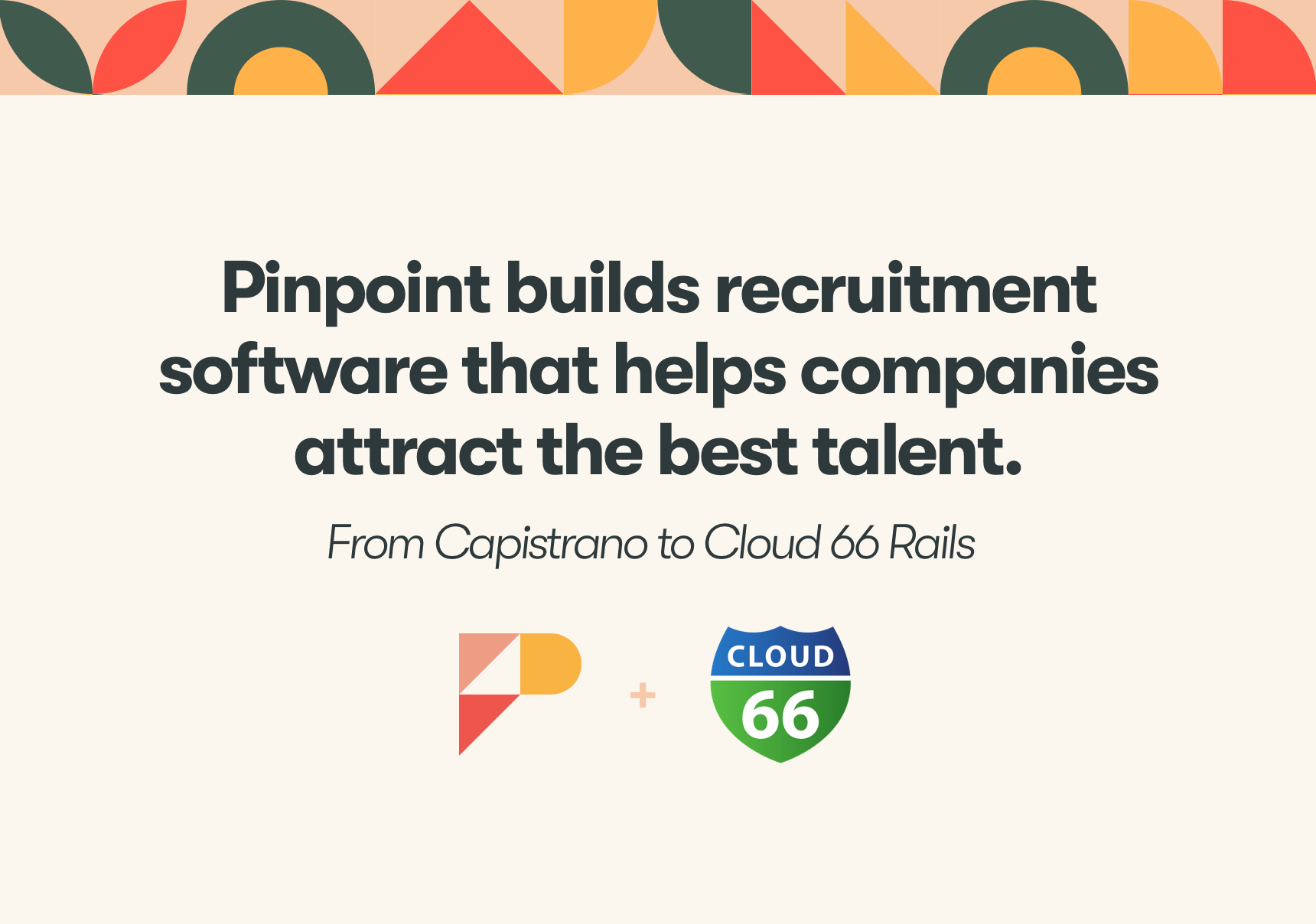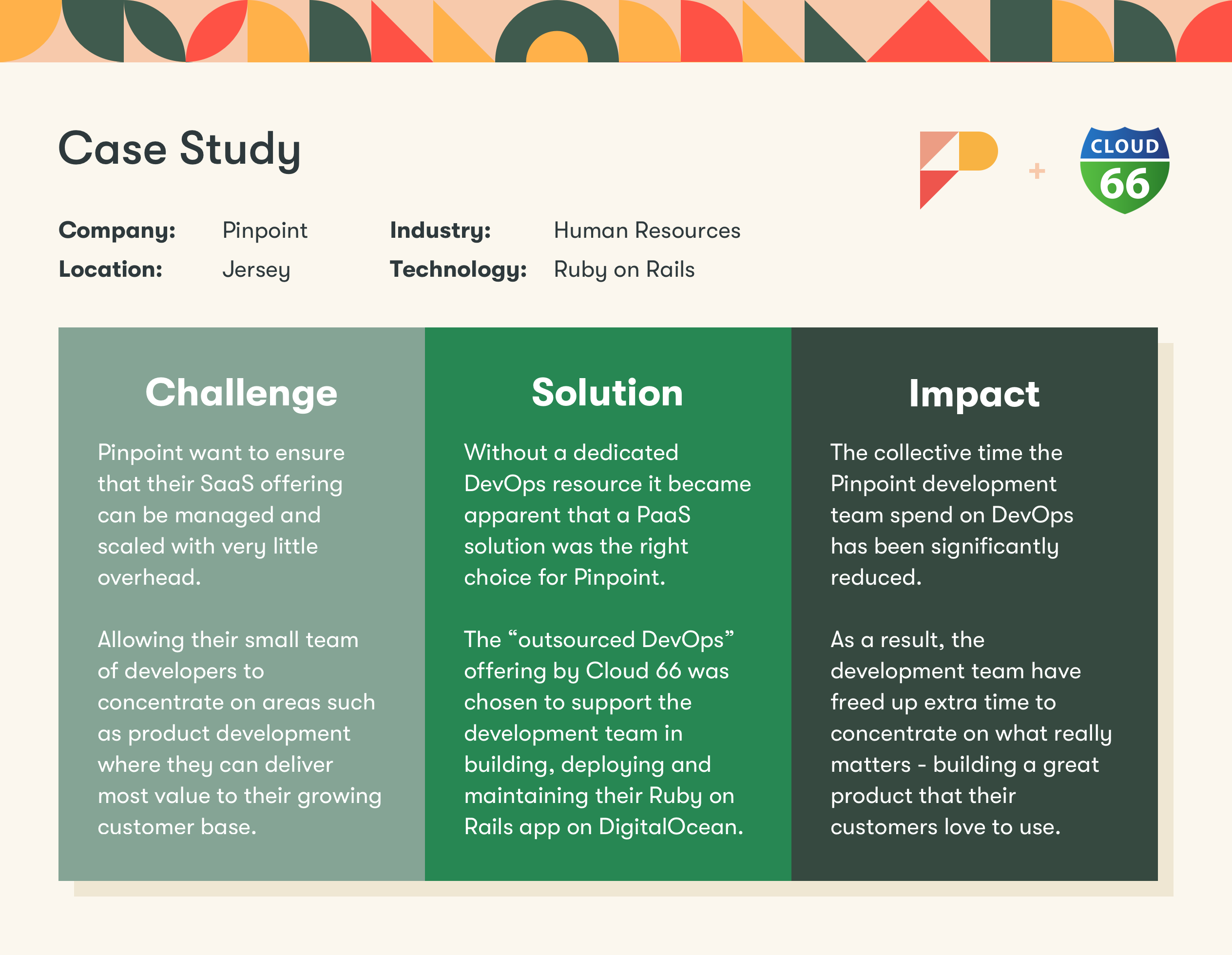This case study features Pinpoint , online recruitment software that automates talent attraction for in-house recruitment teams. It showcases their infrastructure set-up with Cloud 66 for Rails and DigitalOcean.

Pinpoint Background
Tom Luce is CTO and co-founder of Pinpoint - recruitment software that automates recruitment marketing for in-house HR and recruitment teams helping them to attract and hire more of the best talent.
Pinpoint Products & Values. Traditional applicant tracking systems assume that companies are already attracting lots of great applicants for every role. They’re built to help create shortlists of candidates and decide who to hire. Whilst Pinpoint does have powerful selection tools, it’s mainly used by companies that are struggling with the opposite problem - attracting enough high-quality applicants quickly and cost effectively.
People choose Pinpoint’s recruitment software when they want to:
- Attract more of the best candidates without relying on recruitment agencies
- Streamline their recruitment process
- Reduce recruitment costs
There’s no support required from IT and clients are typically up and starting to hire with Pinpoint in just a few weeks. Key features include:
- A fully branded and customizable candidate experience including recruitment website, online application system, candidate emails, and automated interview scheduling.
- Recruitment marketing tools allowing HR teams to create and distribute their own highly targeted recruitment adverts without any prior experience of recruitment marketing.
Who is using Pinpoint? Pinpoint’s clients range from startups to publicly listed utilities companies and everything in between.
These clients are typically attracting 3x more applicants, reducing time to hire by 40%, andreducing recruitment costs by up to 83%.
How to get started? If you want to improve your recruitment process, attract more of the best talent, or reduce your recruitment costs, you canget a free demo of Pinpoint here.
Now, let's ask Tom how Pinpoint manages their infrastructure setup?

Tom, what are your business requirements?
When we started Pinpoint our infrastructure needs were very simple and so we built and managed our own linux servers and used Capistrano as our deployment tool of choice. As we grew I found we were spending far too much time managing the infrastructure and deployment process; time that was very valuable and would be much better spent developing features that our customers wanted.
In looking for a PaaS solution we considered AWS Elastic Beanstalk, Cloud 66 and Heroku. Our business requirements were that any solution had to:
- Minimise time spent on DevOps (deploying, managing, and scaling a Ruby on Rails application.)
- Not being exorbitantly expensive if we had to scale quickly.
- Support MySQL, have integrated backups and have the ability to easily add in services such as Redis and Elasticsearch.
- Ensure we had control over the infrastructure, especially where our application resided.
At Pinpoint we greatly value design and usability, and the relative complexity of Elastic Beanstalk in comparison to Cloud 66 and Heroku’s offerings meant it was discounted after an initial proof of concept had been done.
Heroku have a great offering, however it seemed to be better suited to smaller projects and the lack of control over infrastructure was a dealbreaker.
Why did you choose Cloud 66?
Cloud 66 seemed to strike the perfect balance between being an outsourced DevOps solution whilst still allowing us to maintain control over all the infrastructure. It has a rich feature set and the whole product resonated with me as it appeared to approach DevOps with a convention over configuration philosophy analogous to Ruby on Rails; It aimed to work perfectly out of the box by handling all the tedious setup and orchestration, however still left the option open for you to tweak things if you so wished.
Can you give us an overview of Pinpoint’s infrastructure setup?
We currently use a fairly simple infrastructure setup with load balanced web servers and separate database (MySQL), search (ElasticSearch) and process worker instances.
DigitalOcean was chosen as our cloud provider of choice because of its fantastic uptime, exemplary product, security posture, and ease of use for developers.
As we’re running a Ruby on Rails application with Webpacker, we use the Cloud 66 manifest file to specify the node version that we’d like used. We use CircleCI for continuous integration but all deployments are still triggered manually.
How easy or complicated was the migration to Cloud 66?
The migration took very little time; once we’d connected GitHub and DigitalOcean it was as simple as waiting for the stack analysis to complete, selecting a few configuration options and then waiting for the servers to be built.
Then it was just a question of using the Cloud 66 toolbelt to upload the database, doing some DNS configuration and adding in an SSL certificate. There are great guides for doing all of this within the Cloud 66 Rails documentation.
There were of course a few ‘gotchas’ along the way such as remembering to place the Rails master key in an environment variable, or configuring the Procfile to run Puma as the app server, but all in all the initial setup took perhaps a couple of hours.
How Cloud 66 supports your in-house DevOps team?
We’re still a fairly small team and don’t yet have a dedicated DevOps resource. As such we need to ensure that if something goes down we’re able to quickly figure it out and get everything working again. The ability to access our servers if necessary gives us the comfort that we’ll be able to do that.
Cloud 66 supports the team by allowing any developer with suitable access to perform almost all DevOps tasks without having to touch any actual servers. Almost everything can be done from within the web interface. The app can be scaled, scheduled tasks can be managed, logs can be inspected, firewall rules configured, and server packages can even be updated as part of deployments.
Cloud 66 has been a real game changer for Pinpoint as it’s freed us as a development team to concentrate on what really matters - building a great product that our customers love to use.
What are your plans for the next year?
Our focus for 2019/2020 is scale. We’ve now got a solid product that’s delivering real results for a broad range of clients and our job now is to leverage the success we’ve had to date by investing appropriately across the board.
We’re significantly expanding our headcount, adding to the development team and growing our sales, marketing and customer success functions in support of greater demand for our product. Importantly, we’re also paying close attention to our underlying infrastructure, ensuring it scales in line with our business as we continue to mature – Cloud 66 have been an indispensable partner here and have removed almost all of the pain from this process.
From a product perspective, we’re fortunate to be in a position where we’re starting to generate significant data in a range of formats – customer feedback, insights gleaned from analytics and huge volumes of (anonymised / obfuscated) performance data from the automated advertising we run on behalf of our clients. All of this is invaluable in terms of helping us shape our product roadmap, and when combined with our somewhat unique perspective on the world of recruitment means we’ve got a lot of exciting things coming over the next few months – watch this space!
Thank you, Tom, for finding the time to chat with us about Pinpoint’s Infrastructure. We love to work with the folks at Pinpoint. It's always fantastic to discover all the unique ways in which our customers are using Cloud 66.
